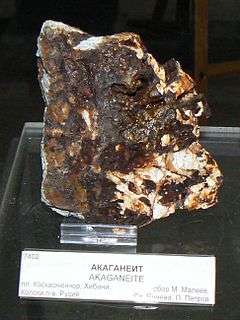Akaganéite
| Akaganeite | |
|---|---|
|
A piece of the mineral akaganeite. Exhibit of the "Earth and Man" Museum in Sofia, Bulgaria. Discovered in Kaskasnyunchorr, Khibiny Massif, Kola Peninsula, Russia | |
| General | |
| Category | Oxide mineral |
| Formula (repeating unit) | Fe3+O(OH,Cl) |
| Strunz classification | 4.DK.05 |
| Crystal system | Monoclinic |
| Crystal class |
Prismatic (2/m) H-M symbol: (2/m) |
| Space group | I2/m |
| Unit cell |
a = 10.561, b = 3.031 c = 10.483 [Å]; β = 90.63°; Z = 1 |
| Identification | |
| Color | Yellowish brown, rusty brown |
| Luster | Earthy |
| Streak | Brownish yellow |
| Diaphaneity | Transparent, translucent |
| Specific gravity | 3.52 |
Akaganeite is an iron(III) oxide-hydroxide / chloride mineral with formula: Fe3+O(OH,Cl) e.g.; β-FeO(OH). It is formed by the weathering of pyrrhotite (Fe1−xS). Nickel also has been reported in the structure. It has a monoclinic crystal structure, a metallic luster and a brownish yellow streak. It is named after the Akagane mine in Iwate, Japan, in which it was discovered. It has also been found in widely dispersed locations around the world and in rocks from the Moon that were brought back during the Apollo Project. The occurrences in meteorites and the lunar sample are thought to have been produced by interaction with Earth's atmosphere.
See also
References
This article is issued from Wikipedia - version of the 11/21/2016. The text is available under the Creative Commons Attribution/Share Alike but additional terms may apply for the media files.
